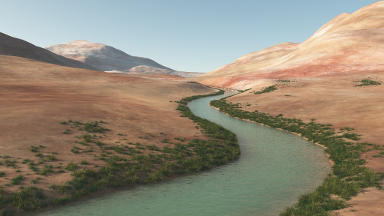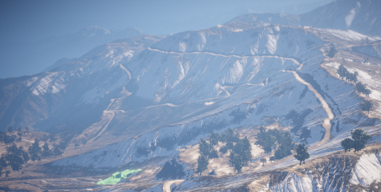-
Hydrology based Terrains at SIGGRAPH
April 14, 2013
 Terrain Generation Using
Procedural Models Based on Hydrology has been accepted at SIGGRAPH.
Terrain Generation Using
Procedural Models Based on Hydrology has been accepted at SIGGRAPH.Watch Terrain Generation using Procedural Models based on Hydrology
We present a framework that allows quick and intuitive modeling of terrains using concepts inspired by hydrology. The terrain is generated from a simple initial sketch, and its generation is controlled by a few parameters. Our terrain representation is both analytic and continuous and can be rendered by using varying levels of detail. The terrain data are stored in a novel data structure: a construction tree whose internal nodes define a combination of operations, and whose leaves represent terrain features. The framework uses rivers as modeling elements, and it first creates a hierarchical drainage network that is represented as a geometric graph over a given input domain. The network is then analyzed to construct watersheds and to characterize the different types and trajectories of rivers. The terrain is finally generated by combining procedural terrain and river patches with blending and carving operators.
-
MANGO Project
December 2012 - September 2014
 The GEOMOD team of LIRIS has
signed a partnership in the context of the MANGO project.
This research and development project aims at creating a new framework for developing video
games. The research program encompasses procedural generation
of terrains with a high level of details, modeling road networks and generating villages for
open-world games.
The GEOMOD team of LIRIS has
signed a partnership in the context of the MANGO project.
This research and development project aims at creating a new framework for developing video
games. The research program encompasses procedural generation
of terrains with a high level of details, modeling road networks and generating villages for
open-world games.We successfully developed methods for generating road networks and villages which were adapted and implemented by UBISOFT for the game Ghost Recon Wildlands which was released in spring 2017 and made it to the top in the video game charts.
-
Procedural generation of villages on arbitrary terrains.
May 1, 2012
Our paper has been accepted at CGI.
Although procedural modeling of cities has attracted a lot of attention for the past decade, populating arbitrary landscapes with non-urban settlements remains an open problem. In this work, we focus on the modeling of small, European villages that took benefit of terrain features to settle in safe, sunny or simply convenient places. We introduce a three step procedural generation method. First, an iterative process based on interest maps is used to progressively generate settlement seeds and the roads that connect them. The fact that a new road attracts settlers while a new house often leads to some extension of the road network is taken into account. Then, an anisotropic conquest method is introduced to segment the land into parcels around settlement seeds. Finally, we introduce open shape grammar to generate 3D geometry that adapts to the local slope. We demonstrate the effectiveness of our method by generating different kinds of villages on arbitrary terrains, from a mountain hamlet to a fisherman village, and validate through comparison with real data.
-
Salt Decay for Virtual City Buildings.
November 22, 2012
Our paper Simulating How Salt Decay Ages Buildings has been accepted at IEEE CG.
Salt-based aging plays an important part in the realism of scenes featuring stone structures and monuments. A proposed model, based on physical behaviors and principles, replaces the simulation of complex physical formulations with ad hoc algorithms. It leads to plausible results, ultimately helping designers create aging patterns on affected objects.
-
European Game Awards.
May 1, 2010
 Gerridae wins the Best Student
Game Awards at the Milthon European Game Awards.
Gerridae wins the Best Student
Game Awards at the Milthon European Game Awards.Gerridae is game coded by the students of Gamagora and presented at the 2010 Paris Game Festival. It was developped by an incredible teams of students under the supervision of industry veterans and myself in 4 months.
-
Eurographics Cover Competition.
May 1, 2010
 This image won the first prize of
the Computer Graphics Forum 2010 Cover
Competition.
It represents a grasping hand made of small stones. This complex model, featuring 17,504
stones (2,315,840 triangles),
was automatically created from a simple mesh model. We use an aperiodic tiling method
for generating the stones into contact without any computationally demanding
physically-based simulation.
Our approach relies on a modified corner cube algorithm
to generate a set of aperiodic tiles, which enables us to avoid visually disturbing
repetitive patterns. Our model allow us to control the shape as well as the relative
orientation and size distribution of the stones.
This image won the first prize of
the Computer Graphics Forum 2010 Cover
Competition.
It represents a grasping hand made of small stones. This complex model, featuring 17,504
stones (2,315,840 triangles),
was automatically created from a simple mesh model. We use an aperiodic tiling method
for generating the stones into contact without any computationally demanding
physically-based simulation.
Our approach relies on a modified corner cube algorithm
to generate a set of aperiodic tiles, which enables us to avoid visually disturbing
repetitive patterns. Our model allow us to control the shape as well as the relative
orientation and size distribution of the stones.